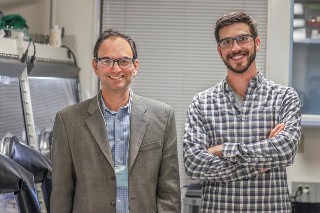Nitash Balsara, a battery scientist at Lawrence Berkeley National Laboratory (Berkeley Lab), and Joseph DeSimone of the University of North Carolina at Chapel Hill, have together discovered a non-flammable electrolyte that holds promise for safe lithium batteries.
 Two of Blue Current’s three co-founders, Nitash Balsara (left) and Alex Teran. (Photo courtesy Blue Current)
Two of Blue Current’s three co-founders, Nitash Balsara (left) and Alex Teran. (Photo courtesy Blue Current)
For many years, Balsara had been conducting research on methods to enhance the safety of lithium-ion batteries. He now believes that the solution has been found in a class of compounds that is used for industrial lubrication applications.
Balsara, Joseph DeSimone and Alex Teran, who is a former graduate student of Balsara’s have together, co-founded the startup company named as Blue Current, which is based in Berkeley, California. This startup has received backing from Faster LLC, an investment firm, for advancing their non-flammable electrolyte.
An electrolyte is defined as a chemical substance that has the capability to carry electrical charge between the anode and cathode of a battery during the charging and discharging process in the cell. Conventional lithium batteries utilize electrolytes that are flammable, and fires may occur due to thermal runaway. The possibilities of their failure increases as the use of lithium batteries become more prevalent and its size also increases. Lithium batteries are used in cell phones, laptops, electric cars, power grid and airplanes.
With current lithium batteries safety is engineered through the battery management system. Although they are generally considered safe, you still have an electrolyte in the battery that is flammable, and every so often something might go wrong. We want to take that anxiety out of the battery.
Nitash Balsara, a battery scientist at Lawrence Berkeley National Laboratory (Berkeley Lab)
The electrolyte developed at Blue Current is perfluoropolyether (PFPE), which is a fluorinated liquid. “Things that contain fluorine don’t burn very easily,” said Balsara, a researcher in the Materials Sciences and Energy Storage Divisions of Berkeley Lab and also a professor of Chemical and Biomolecular Engineering at UC Berkeley. “They’ll evaporate, but they won’t catch fire.”
Balsara, DeSimone, and other co-authors had published a paper in the Proceedings of the National Academy of Science, where they had shown that the PFPE-based electrolytes developed by them were compatible with typical battery electrodes and “exhibit reasonable conductivity and unprecedented transference numbers.” The transference number is a critical parameter that influences the performance of the battery. The relatively effortless manner in which the lithium ions move within the electrolytes is known as the transference number.
Currently, there is no non-flammable lithium battery available in the market. Many researchers are attempting to create a non-flammable lithium battery. In 2007, Balsara had co-founded Seeo, which was his first battery company. This company was based on a non-flammable dry polymer electrolyte, which was one among Balsara’s other inventions. Samsung Ventures had recently made a major investment in Seeo. However, Balsara does not have any direct involvement with the company now.
Presently, Blue Current has three battery scientists. The company is planning to recruit more battery scientists. The safe passage of current through the batteries has been reflected in the name “Blue Current.”
The researchers are currently facing the challenge of ways to improve the PFPE electrolyte’s conductivity.
Because the fluorinated compound is not as conductive, you can’t charge these batteries very quickly, and you can’t draw current very quickly. The company’s research goal is to hasten the ions’ motion through the electrolyte.
Nitash Balsara, a battery scientist at Lawrence Berkeley National Laboratory (Berkeley Lab)
When discharge occurs slowly, it would affect the acceleration required when the accelerator pedal in the electric car is stepped on. “If there’s a truck coming, you need to accelerate, he said. “So while this electrolyte may not be ideal for vehicles at this point, there are other applications where the rate of discharge is not as important.”
In order to increase the speed of motion of lithium ions, the researchers at Blue Current are attempting to modify the electrolyte’s molecular structure. There are applications that do not require response from batteries in terms of seconds or minutes. Some people who have installed solar panels would like to store the harvested energy for use during the night or during rainy days. “There are applications where safety is not a luxury but a necessity,” Balsara said.
References